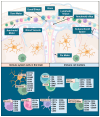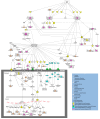Understanding the Immune System and Biospecimen-Based Response in Glioblastoma: A Practical Guide to Utilizing Signal Redundancy for Biomarker and Immune Signature Discovery
- PMID: 39851932
- PMCID: PMC11763554
- DOI: 10.3390/curroncol32010016
Understanding the Immune System and Biospecimen-Based Response in Glioblastoma: A Practical Guide to Utilizing Signal Redundancy for Biomarker and Immune Signature Discovery
Abstract
Glioblastoma (GBM) is a primary central nervous system malignancy with a median survival of 15-20 months. The presence of both intra- and intertumoral heterogeneity limits understanding of biological mechanisms leading to tumor resistance, including immune escape. An attractive field of research to examine treatment resistance are immune signatures composed of cluster of differentiation (CD) markers and cytokines. CD markers are surface markers expressed on various cells throughout the body, often associated with immune cells. Cytokines are the effector molecules of the immune system. Together, CD markers and cytokines can serve as useful biomarkers to reflect immune status in patients with GBM. However, there are gaps in the understanding of the intricate interactions between GBM and the peripheral immune system and how these interactions change with standard and immune-modulating treatments. The key to understanding the true nature of these interactions is through multi-omic analysis of tumor progression and treatment response. This review aims to identify potential non-invasive blood-based biomarkers that can contribute to an immune signature through multi-omic approaches, leading to a better understanding of immune involvement in GBM.
Keywords: biomarkers; glioblastoma; immune response; immune system; tumor resistance.
Conflict of interest statement
The authors declare no conflicts of interest.
Figures







Similar articles
-
Systematic identification, development, and validation of prognostic biomarkers involving the tumor-immune microenvironment for glioblastoma.J Cell Physiol. 2021 Jan;236(1):507-522. doi: 10.1002/jcp.29878. Epub 2020 Jun 22. J Cell Physiol. 2021. PMID: 32572951
-
GLIO-Select: Machine Learning-Based Feature Selection and Weighting of Tissue and Serum Proteomic and Metabolomic Data Uncovers Sex Differences in Glioblastoma.Int J Mol Sci. 2025 May 2;26(9):4339. doi: 10.3390/ijms26094339. Int J Mol Sci. 2025. PMID: 40362575 Free PMC article.
-
Identification of Immune-Related lncRNA Prognostic Signature and Molecular Subtypes for Glioblastoma.Front Immunol. 2021 Nov 25;12:706936. doi: 10.3389/fimmu.2021.706936. eCollection 2021. Front Immunol. 2021. PMID: 34899682 Free PMC article.
-
Circulating Liquid Biopsy Biomarkers in Glioblastoma: Advances and Challenges.Int J Mol Sci. 2024 Jul 21;25(14):7974. doi: 10.3390/ijms25147974. Int J Mol Sci. 2024. PMID: 39063215 Free PMC article. Review.
-
Explicating the Pivotal Pathogenic, Diagnostic, and Therapeutic Biomarker Potentials of Myeloid-Derived Suppressor Cells in Glioblastoma.Dis Markers. 2020 Nov 4;2020:8844313. doi: 10.1155/2020/8844313. eCollection 2020. Dis Markers. 2020. PMID: 33204365 Free PMC article. Review.
Cited by
-
Immune intrinsic escape signature stratifies prognosis, characterizes the tumor immune microenvironment, and identifies tumorigenic PPP1R8 in glioblastoma multiforme patients.Front Immunol. 2025 Aug 6;16:1577920. doi: 10.3389/fimmu.2025.1577920. eCollection 2025. Front Immunol. 2025. PMID: 40842996 Free PMC article.
References
-
- Stupp R., Hegi M.E., Mason W.P., van den Bent M.J., Taphoorn M.J., Janzer R.C., Ludwin S.K., Allgeier A., Fisher B., Belanger K., et al. Effects of radiotherapy with concomitant and adjuvant temozolomide versus radiotherapy alone on survival in glioblastoma in a randomised phase III study: 5-year analysis of the EORTC-NCIC trial. Lancet Oncol. 2009;10:459–466. doi: 10.1016/S1470-2045(09)70025-7. - DOI - PubMed
-
- Vaubel R.A., Tian S., Remonde D., Schroeder M.A., Mladek A.C., Kitange G.J., Caron A., Kollmeyer T.M., Grove R., Peng S., et al. Genomic and Phenotypic Characterization of a Broad Panel of Patient-Derived Xenografts Reflects the Diversity of Glioblastoma. Clin. Cancer Res. 2020;26:1094–1104. doi: 10.1158/1078-0432.CCR-19-0909. - DOI - PMC - PubMed
-
- Hanahan D. Hallmarks of Cancer: New Dimensions. Cancer Discov. 2022;12:31–46. doi: 10.1158/2159-8290.CD-21-1059. - DOI - PubMed
Publication types
MeSH terms
Substances
Grants and funding
LinkOut - more resources
Full Text Sources
Medical

